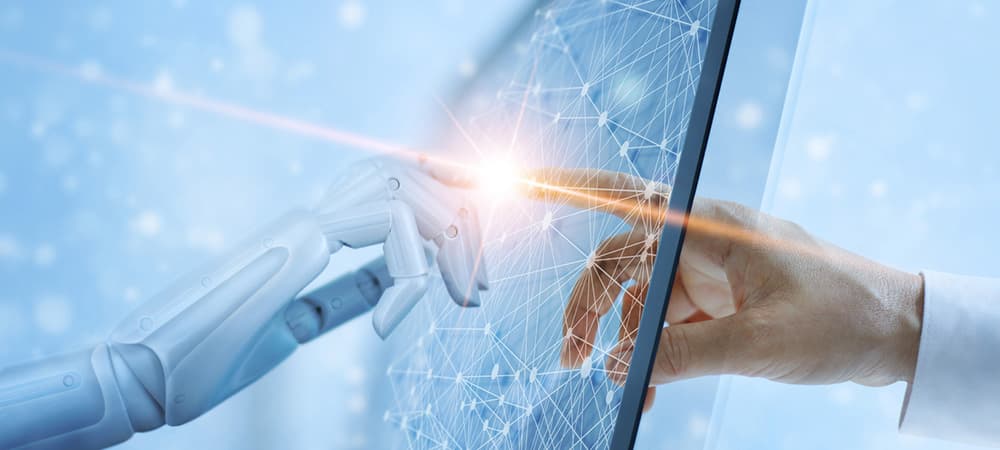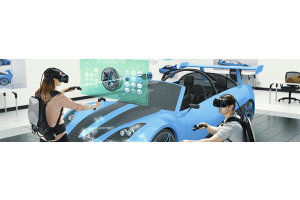We use cookies to offer you a better experience. For more information on how we use cookies you can read our Cookie and Privacy Policy.
Where the Fourth Industrial Revolution is Taking Us
August 10, 2019

Have you ever taken a step back from our fast-paced world to think about the larger-than-life advances being made on a daily basis? Our everyday lives are inundated with advanced technology that was far from conceivable reality even 20 years ago. Living on the cusp of the Fourth Industrial Revolution (FIR) challenges and changes the way we think and operate as human beings.
Communication is key
What separates the Fourth Industrial Revolution from the previous digital revolution is the focus on advancing communication and connectivity methods rather than advancing the technology itself. The societal implications behind the FIR aim to improve quality of life, raise income levels, and bridge the gap between global inequalities.
The future is near, and it’s brighter than ever. As we ramp up towards the gateway into the Fourth Industrial Revolution, we can expect an influx of powerful devices, networks, and digital services to reshape our human existence. Let’s take a deep dive into the what the 4th Industrial Revolution is, how it will shift communication and connectivity landscapes, and how world leaders in all industries are planning to prepare for the next golden age.
What is the Fourth Industrial Revolution?
Founder of the World Economic Forum, Klaus Schwab was the first to refer to the rising digital age as the Fourth Industrial Revolution. Characterized by a mass of emerging technological breakthroughs that blur the lines between the physical, biological, and digital, the FIR is the next major industrial shift humankind will see.
Schwab has often associated the 4th Industrial Revolution with the second machine age for the calculated effects digitization and artificial intelligence will have on the global economy. Even today, we can see the immense impact modern technology is leaving in its groundbreaking wake. In fact, Schwab details that the accelerated speed of modern innovation has no historical precedent that comes close to comparison.
We are living amidst a rapidly changing global landscape that is bringing nanotechnology, biotechnology, quantum computing, and more into every economic industry in every country. In his book The Fourth Industrial Revolution, Schwab recognizes that the changes are so profound that, from the perspective of human history, there has never been a time of greater promise or potential peril. Today, we are hurtling toward this fast-approaching age of hyper-digital integration, and there are no signs of stopping.
How is the Fourth Industrial Revolution different from prior industrial revolutions?
Industrial revolutions all share a commonality; the invention of a transformative technology that changes society on a fundamental and economic scale. In order to understand the stark differences between the 4th Industrial Revolution and the previous three, you’ll need to understand the time periods from which they stem.
Dating back to the mid-1700s, the First Industrial Revolution grew agrarian, rural societies into urban and industrial organisms with the invention of the steam engine. Granting us independence from animal labor and the forces of nature to move goods and people, the steam engine was a significant marker of human development. Population increases, better standards of living, and the creation of established factory manufacturing processes reshaped much of the world.
Between the years of 1870 and 1914, the Second Industrial Revolution marked the years of wild growth and expansion within the steel, textile, oil, and electrical industries. From these disparate industries came the automobile, telephone, phonograph, airplane, and light bulb. The Second Industrial Revolution enabled globalization - a rough draft of sorts for our modern day society.
Today, we are living in the Third Industrial Revolution, also known as the Digital Revolution. The invention and rapid advancement of the computer and the internet are the defining highlights of the digital age. A world of global opportunities has been opened up by the fruits of the digital age. The way in which people and businesses work together has transformed drastically within the modern digital revolution.
Standing on the precipice of the 4th Industrial Revolution, we have already begun to see the sparks of new inventions and technological integrations that are reshaping how we function as a human race. Much like the previous industrial revolution, the fourth chapter aims to change the way we work, live, and relate to one another. However, unlike the past revolutions, the FIR aspires to merge physical, digital, and biological spheres to foster an inclusive, human-centered future.
In essence, the Fourth Industrial Revolution looks beyond pure technological advances and concentrates on innovative methods of accomplishing the greatest good for the greatest number of people, communities, and organization. The cutting-edge tech is there, but the question of how it can shape the future is the driving force behind the Fourth Industrial Revolution.
What can we expect from the Fourth Industrial Revolution?
One of the reasons the science-fiction genre is so popular among movie-watchers and book-readers is that venturing into the unknown is equal parts exciting and frightening. Things we could have never imagined possible just a few years ago are now realities that live and walk among us every day.
From handheld supercomputers (are you reading this on your smart phone?) to artificial intelligent virtual assistants docked on our kitchen counters, these incredible tech inventions have become mere everyday items we often overlook. Behind these objects and inventions lies a world of opportunity waiting to take flight on a global scale. These emerging tech breakthroughs include 3D printing, automated driving, Internet of Things, renewable energy, quantum computing, artificial intelligence, and fifth-generation (5G) wireless technology.
1. 3D printing
What it is: 3D printing, or additive manufacturing, is the process in which digital computer-aided design (CAD) files are transformed into tangible three-dimensional objects in real-time.
How it’s changing the world: The concept of turning nothing into something typically leans more on the side of magical innovation, but the introduction of well-oiled 3D printing machines has made it a feasible modern procedure. 3D printing reduces overall machine, material, and labor costs.
Unlike a traditional assembly line that requires a number of skilled technicians for proper mass-production, 3D printing automates mass-production, requiring a single operator to initiate the process. No skilled technicians are needed once the CAD design is ready.
2. Automated driving
What it is: Automated vehicles are self-driving cars that follow given directions and adopt key lane-keeping and car-following guidelines.
How it’s changing the world: Tesla is one of the companies in the car market looking to bring automated driving onto the roads. Known for their futuristic builds, battery dependence, and high-tech functionality, Tesla vehicles are paving the way for a future of self-driving technology.
By incorporating auto-pilot functionality, automated cars aim to optimize traffic and fuel efficiency while making roads safer. In fact, an Eno Centre for Transportation study found that if 90% of cars on American roads were automated, the number of annual accidents would drop from 6 million a year to 1.3 million.
3. Internet of Things
What it is: The Internet of Things(IoT) is a massive network of interrelated web-connected digital devices that are engineered to aggregate and exchange data. In essence, the Internet of Things is a system of systems that aims to collect real-time information to problem-solve and advance the human experience.
How it’s changing the world: The Internet of Things and all of its connected devices are rapidly transforming how we interact with technology and how technology interacts with us. Through sensor data collection and actuator control, IoT platforms will increase efficiency and accuracy without the need for human intervention.
A simple example of this on a tiny scale would be an IoT thermometer automatically turning on lights and setting the temperature the moment you step into the door. IoT devices take human interference out of the equation. On a larger scale, the Internet of Things excels at finding a solution to every problem.
4. Renewable energy
What it is: Renewable energy comes from clean, natural sources that are constantly replenished and cannot be depleted. Sunlight, water, and wind are all natural resources that can be converted into renewable energy sources so long as the sun shines, oceans are filled, and the wind blows.
How it’s changing the world: Dirty energy sources have a massive impact on our environment and come with a long-running list of long-lasting consequences. Fossil fuels pollute our air, water, and land, while they take harmful tolls on public health, wildlife, and global warming emissions. Renewable energy moves away from this.
Using energy sources that produce zero greenhouse gas emissions works to alleviate the catastrophic weight of global climate change - effectively making the world a cleaner, safer place to live in.
5. Artificial intelligence
What it is: Artificial intelligence (AI) makes it possible for machines to simulate human intelligence by learning from experience and adjusting to new inputs. In addition to learning, artificial intelligence machines are capable of reasoning and self-correction.
How it’s changing the world: Today, AI lives in our smartphones, on our computers, and within our favorite subscription services. The future of AI incorporates different advancement levels and a wide array of integration opportunities that will work to enhance socio-economic landscapes. Increasing automation, solving complex problems, adding jobs to the market, and boosting the quality of life are all benefits AI bring to the future’s table.
6. Fifth-generation wireless technology
What it is: Fifth-generation wireless (5G) is a superior data communication to today’s fourth-generation (4G) wireless connectivity. 5G wireless is capable of reaching speeds up to 100 Gbps and covering distances up to 90 meters through beamforming. 5G focuses on increasing bandwidth to be smarter, faster, and more efficient than 4G.
How it’s changing the world: With the tides of tech change and advancement, the systems that support their internet-based connections need to be strengthened as well. From driverless cars to IoT devices, these digital entities require high-speed wireless infrastructure to keep up with the rapidly changing technological landscape.
7. Biotechnology
What it is: According to the Biotechnology Innovation Organization, biotechnology harnesses cellular and biomolecular processes to develop technologies and products that help improve our lives and the health of our planet.
How it’s changing the world: Biotechnology advances work toward three main end-goals; healing the world, fueling the world, and feeding the world. Through biotech developments and innovation, scientists will become more able to combat debilitating diseases, use cleaner energy, provide food for the hungry, and reduce global carbon footprints.
Where is the Fourth Industrial Revolution taking us?
On a personal level, we appreciate the convenience and efficiency of a digitally connected world, but the revolution begins when these high-tech integrations inundate our world on an economic and societal scale. Creating “smarter” industries that have the power to affect socioeconomic landscapes takes plenty of careful planning and a certain acceptance of momentous changes that humankind has never seen before.
It’s this giant leap of faith that Schwab predicts will be the biggest roadblock standing between modern society and the 4th Industrial Revolution. Schwab noted, “my concern, however, is that decision-makers are too often caught in traditional, linear (and non-disruptive) thinking or too absorbed by immediate concerns to think strategically about the forces of disruption and innovation shaping our future."
In essence, taking these huge tech integration steps to the next level takes a fair amount of scaling that politicians, world leaders, CEOs, and policymakers will likely meet with hesitation. There is no denying the promise and potential the 4th Industrial Revolution will bring, it’s a simple matter of preparation and execution that keeps modern day society standing on the precipice of changing times.
The future can be a gray space where the mystery of the unknown clouds the mind, but the vast majority of Americans have already seen a number of tech integration changes that affect our homes, workplaces, businesses, and more. Schwab says, “In the end, it all comes down to people and values. We need to shape a future that works for all of us by putting people first and empowering them.” The Fourth Industrial Revolution aims to accomplish that, and much, much more.
[1] Foreign Affairs; The Fourth Industrial Revolution
[3] World Economic Forum; Fourth Industrial Revolution
[4] Eno Center for Transportation; Preparing a Nation for Autonomous Vehicles: Opportunities, Barriers and Policy Recommendations
[5] IEEE Spectrum; 5G Bytes: Beamforming Explained
[6] Biotechnology Innovation Organization; What is Biotechnology?
[7] Klaus Schwab; The Fourth Industrial Revolution
[8] World Economic Forum; Fourth Industrial Revolution
About the Author: Tulie Finley-Moise is a contributing writer for HP® Tech Takes. Tulie is a digital content creation specialist based in San Diego, California with a passion for the latest tech and digital media news.
Article reposted with permission from HP Tech Takes






